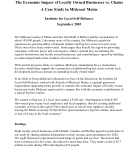Three times as much money stays in the local economy when you buy goods and services from locally owned businesses instead of large chain stores, according to an analysis by the Institute for Local Self-Reliance and Friends of Midcoast Maine.
The study tracked the revenue and expenditures of eight locally owned businesses in the Maine towns of Rockland, Camden, and Belfast. The businesses—which represented a range of goods and services—collectively employed 62 people and had sales of $5.7 million in 2002.
The survey found that the businesses spent 44.6 percent of their revenue within the surrounding two counties. Another 8.7 percent was spent elsewhere in the state of Maine. The four largest components of this local spending were: wages and benefits paid to local employees; goods and services purchased from other local businesses; profits that accrued to local owners; and taxes paid to local and state government.
All eight of the surveyed businesses banked with locally owned banks. They purchased inventory from local manufacturers, advertised in local newspapers, and hired local accountants, printers, internet service providers, and repair people.
The other 46.7 percent of their revenue left the state. This out-of-state spending included inventory purchased from out-of-state companies, mortgage interest, rent, credit card fees, supplies, insurance, and equipment leasing.
A similar expenditure profile was created for a major big box retailer with outlets in Maine. Because national retailers do not reveal detailed financial information, the study estimates local expenditures (payroll, supplies, services, utilities, taxes, etc.) based on national data, statements by company officials, and information on one of its Maine outlets. The study estimates that the chain returns just 14.1 percent of its revenue to the local economy, mostly in the form of payroll. The rest leaves the state, flowing to out-of-state suppliers or back to corporate headquarters.
From an economic development perspective, the ramifications of the study are substantial. Based on current growth rates, annual retail sales in the three cities will expand by $74 million over the next four years. If all of this additional spending were captured by new and expanding locally owned businesses, it would add $23 million more to the local economy each year than if all of the new spending were captured by chains.
The survey also found that the local businesses contributed more to charity than national chains. The eight businesses made $24,000 in cash donations, which amounts to 0.4 percent of their revenue. That’s four times as much, relative to overall sales, as Wal-mart gave to charity in 2002, and twice as much as Target gave.
More:
- — The Economic Impact of Locally Owned Businesses vs. Chains: A Case Study in Midcoast Maine – New Rules Project, September 2003
- — Friends of Midcoast Maine
- — A study earlier this year in Austin, Texas, reached similar conclusions.
——
Reprint Policy: We generally allow articles to be reprinted for non-commercial purposes, provided you attribute the article to the New Rules Project, include our web address, and do not alter or edit it in any way. Please contact us for permission to reprint this or other articles.



